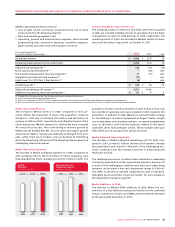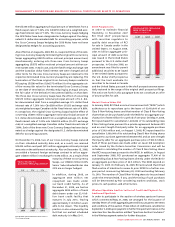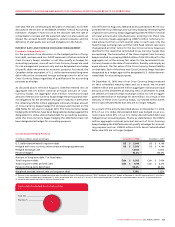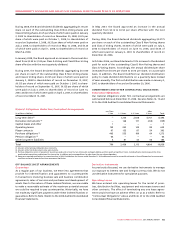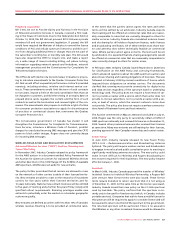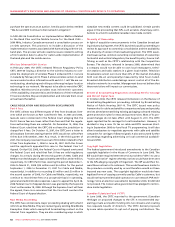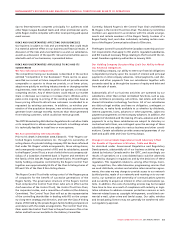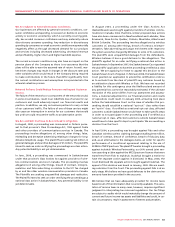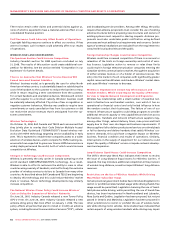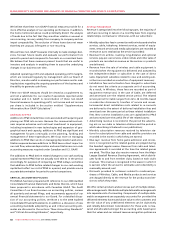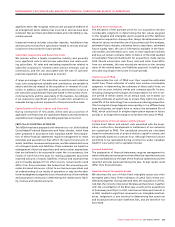Rogers 2008 Annual Report Download - page 63
Download and view the complete annual report
Please find page 63 of the 2008 Rogers annual report below. You can navigate through the pages in the report by either clicking on the pages listed below, or by using the keyword search tool below to find specific information within the annual report.
ROGERS COMMUNICATIONS INC. 2008 ANNUAL REPORT 59
MANAGEMENT’S DISCUSSION AND ANALYSIS OF FINANCIAL CONDITION AND RESULTS OF OPERATIONS
report did not propose increases in the contributions currently paid
by broadcasting distribution undertakings (“BDU”) such as Cable.
Internet Traffic Management
In November 2008, the CRTC issued Telecom Public Notice 2008-19
initiating a proceeding to consider Internet traffic management
practices for both wholesale and retail Internet services. The pro-
ceeding will include an oral public hearing in July 2009.
Essential Facilities
In June 2008, the Federal Court of Appeal denied the leave to
appeal application from Bell Canada et al which sought to appeal
the CRTC’s essential facilities decision. Bell Canada and other parties
also applied to the CRTC with review and vary applications seeking
to reverse some limited aspects of the essential facilities decision.
Rogers generally opposed these review and vary applications.
Three of these applications were denied by the CRTC in December
2008. In January 2009, in response to the last application, the CRTC
did amend its Decision in order to permit negotiated agreements
for certain services. The amendment provides the incumbent local
telephone companies with additional pricing flexibility.
MEDIA REGULATION AND REGULATORY DEVELOPMENTS
Commercial Radio Copyright Tariffs
In February 2008, the Copyright Board reaffirmed the rates it set
in 2005 for fees payable to the Society of Composers, Authors and
Music Publishers of Canada (“SOCAN”) and Neighbouring Rights
Collective of Canada (“NRCC”) for use of music from 2003 to 2007.
In its reaffirmation of the SOCAN-NRCC decision, the Copyright
Board also granted the CAB’s request for a consolidated tariff pro-
ceeding. The CAB hopes to persuade the Copyright Board to set an
overall valuation for the use of music by commercial radio, which
would then be divided amongst the collectives.
The consolidated radio tariff proceeding commenced in December
2008, with the Copyright Board considering tariff proposals filed
by music collectives: SOCAN, NRCC, CSI, AVLA/SOPROQ, and ArtistI.
The CAB is representing radio broadcasters and will argue for an
“all-in broadcaster tariff” that, if achieved, will effectively ration-
alize payments and reduce the impact of the collectives’ multiple
tariff demands. The CAB is arguing that from a pure economic
standpoint, the combined rate should be 2.8% for all tariffs. In the
alternative “multiple tariff” approach, the maximum combined
rate should be 5.96%. With respect to talk-based radio stations,
the CAB is arguing that the existing 20% “low music rate” should
continue, and a “very low music rate” for stations at or below 5%
music use (exclusive of production music) should be set at a “double
discount”. A decision is anticipated in 2009.
New Media Proceeding
Further to the issues noted above under Cable, the CRTC’s New
Media proceeding will also consider whether obligations (content
and/or spending) should be imposed on websites containing broad-
cast content and particularly sites linked to traditional (regulated)
broadcast stations and services (e.g.Citytv.com; Sportsnet.ca).
Review of Broadcasting Regulations
Further to the issues noted above under Cable (Review of
Broadcasting Regulations), the CRTC’s new policy for the distribu-
tion of specialty services has also opened up mainstream sports and
national news genres to competition with the removal of genre
protection entirely for these services including Rogers Sportsnet.
Accordingly, these services will no longer have genre protection or
mandatory access requirements (“must carry” rights). As a result,
Rogers Sportsnet will no longer be required to limit its service to
regional sports and can compete directly with TSN as a national
sports service.
Rogers’ over-the-air television stations will have limited access to
the CRTC’s new local TV fund as our stations operate primarily in
urban markets. Citytv, and OMNI to a lesser extent, post-August 31,
2011, will be able to negotiate payments with cable and satellite
companies for carriage of their signals into distant markets.
Licence Renewals
In February 2009, the CRTC announced that it intends to issue one-
year renewals for all private conventional television stations. This
process will allow it to consider group-based (conventional and
discretionary specialty) licence renewals in the spring of 2010. The
Rogers group would include the Citytv and OMNI conventional
television stations and the specialty services; Rogers Sportsnet,
G4TechTV Canada, OLN and The Biography Channel Canada. A
CRTC hearing will occur in April 2009 which may affect conven-
tional station licences in regard to Canadian programming prior to
the spring 2010 process.
COMPETITION IN OUR BUSINESSES
We currently face significant competition in each of our primary
businesses from entities providing substantially similar services.
Each of our segments also faces competition from entities utilizing
alternative communications and transmission technologies and may
face competition from other technologies being developed or to be
developed in the future. Below is a discussion of the specific compe-
tition facing each of our Wireless, Cable and Media businesses.
Wireless Competition
At December 31, 2008, the highly-competitive Canadian wireless
industry had approximately 21.7 million subscribers. Competition
for wireless subscribers is based on price, scope of services, service
coverage, quality of service, sophistication of wireless technology,
breadth of distribution, selection of equipment, brand and mar-
keting. Wireless also competes with its rivals for dealers and retail
distribution outlets.
In the wireless voice and data market, Wireless competes primar-
ily with two other national wireless service providers and regional
players, and with resellers such as Virgin Mobile Canada, Primus,
Vidéotron, and other emerging providers using alternative wireless
technologies, such as WiFi “hotspots”. Wireless messaging (or one-
way paging) also competes with a number of local and national
paging providers and potential users of wireless voice and data
systems may find their communications needs satisfied by other
current or development technologies, such as WiFi “hotspots” or
trunk radio systems, which have the technical capability to handle
mobile telephone calls.


